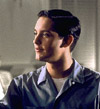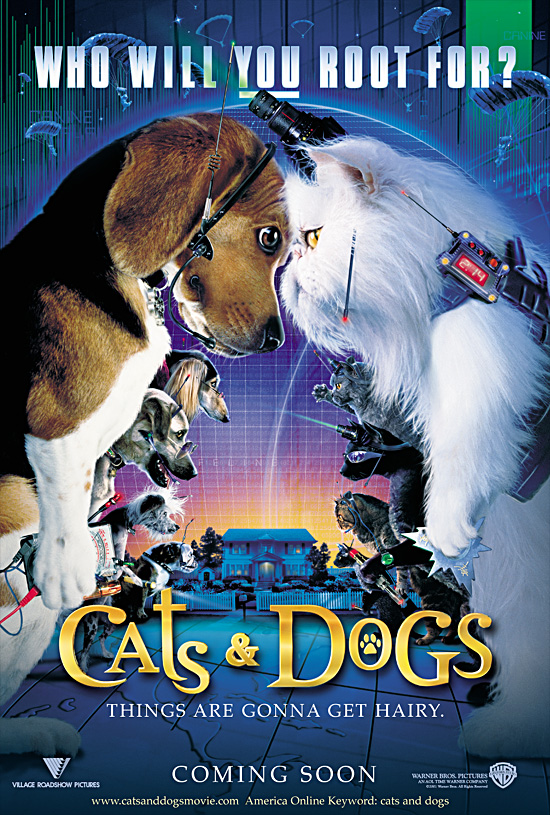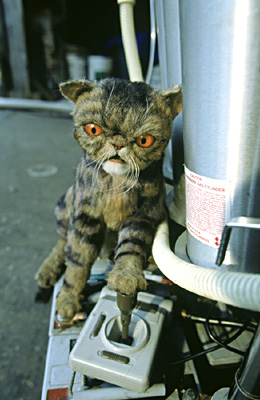
As AV turns 15, let's take a look back at the site we descended from. Below you can explore the database Olivier compiled at Animated Movies during its existence, as it last appeared online in October 2003.
 | Animated Movies was launched by Olivier Mouroux in 1999. In addition to a daily news report, he also created a database of information about past, current, and upcoming films. In 2003, he took a job in the industry and had to give up his work on the site. Several fans of Animated Movies decided to take on the task of keeping the news portion of his site going, and founded what is now Animated Views. As AV turns 15, let's take a look back at the site we descended from. Below you can explore the database Olivier compiled at Animated Movies during its existence, as it last appeared online in October 2003. |
Directed by: Lawrence Guterman
Written by: Glenn Ficarra & John Requa
 Production
Started on: Computer animation of this movie started in early
2000; live-action production started in Vancouver, Canada on June 19th,
2000 and wrapped on November 9th, 2000.
Production
Started on: Computer animation of this movie started in early
2000; live-action production started in Vancouver, Canada on June 19th,
2000 and wrapped on November 9th, 2000.
Released on: July 4, 2001
Running Time: 87 minutes
Budget: $60 million
U.S. Opening Weekend: $21.707 million
over 3,040 screens
Box-Office: $93.38 million in the U.S.,
$200.7 million worldwide
 |
 |
 |
 |
 |
 |
 |
Dogs (voices)
 Young
pup... Tobey Maguire
Young
pup... Tobey Maguire
Ivy... Susan Sarandon
Sam, a large friendly dog... Michael Clarke Duncan
Calico... Jon Lovitz
Electronic expert... Joe Pantoliano
Humans
Mr. Brody (scientist who invented the vaccine)... Jeff Goldblum
Mrs. Brody (the scientist's wife)... Elizabeth Perkins
And
Butch... Alec Baldwin
Scott... Alexander Pollock
There is a secret war going on between cats and dogs that humans don't
even know about, a war that could effect the entire planet. In an average
American household, a father scientist has come up with a cure for people
who are allergic to dogs. The cats fear that this might tip the global
scales in favor of the dogs, and set out on a covert mission to find and
undermine the formula. The dogs aim to defend the household from
this feline invasion.

The scientist's young, eager pup is asked by the dog world's secret
service to protect the vaccine, with the help of a few allies: a wise and
worldly dog who looks out for him; a big, friendly dog who isn't quite
the military operative he thinks he is; and a small, hyperkinetic dog who
is an electronics expert.
![]() The project was
initially developed by Warner Bros. Feature Animation as a vehicle for
none other than Sylvester the Cat. The first draft of the script also featured
Sam Sheepdog, the laconic protagonist of a series of Chuck Jones cartoons
from the 1950s (and while Sylvester is gone, Sam has remained as a kind
of homage and is voiced in the film by Michael Clarke Duncan). Why the
change to digitized live action? "I think Warners saw some opportunity
to break ground," John Requa, co-writer, with Glenn Ficarra, of "Cats &
Dogs." "They said, 'If you do an animated film, how much attention will
it get? But if you do it CG,'" with computer graphics, the possibilities
seemed infinite. After the entire film had been storyboarded for
animation, plans were changed to shoot the picture largely in live action,
with an array of real dogs and cats, and state-of-the-art digitally animated
lip-syncing and facial expressions created by Rhythm & Hues, the shop
that pioneered the talking-animal movie genre with 1995's Babe.
The project was
initially developed by Warner Bros. Feature Animation as a vehicle for
none other than Sylvester the Cat. The first draft of the script also featured
Sam Sheepdog, the laconic protagonist of a series of Chuck Jones cartoons
from the 1950s (and while Sylvester is gone, Sam has remained as a kind
of homage and is voiced in the film by Michael Clarke Duncan). Why the
change to digitized live action? "I think Warners saw some opportunity
to break ground," John Requa, co-writer, with Glenn Ficarra, of "Cats &
Dogs." "They said, 'If you do an animated film, how much attention will
it get? But if you do it CG,'" with computer graphics, the possibilities
seemed infinite. After the entire film had been storyboarded for
animation, plans were changed to shoot the picture largely in live action,
with an array of real dogs and cats, and state-of-the-art digitally animated
lip-syncing and facial expressions created by Rhythm & Hues, the shop
that pioneered the talking-animal movie genre with 1995's Babe.

![]() Warner Brothers acquired this pitch in 1998 from John Requa and Glenn Ficarra.
Warners is developing as a potential franchise.
Warner Brothers acquired this pitch in 1998 from John Requa and Glenn Ficarra.
Warners is developing as a potential franchise.
![]() The voice and
live action casting were announced officially in late Spring 2000.
The voice and
live action casting were announced officially in late Spring 2000.
![]() A scene from the
original screenplay had the cats infiltrating the house "by sending in
a cute kitten. In truth, the kitten isn't young, but is an older cat operative
who's undergone painful surgery to look cute and young. The family
finds it on its doorstep and takes it in. The puppy knows that the
kitten's a bad guy, so he starts to try to figure out how to get it out
of there. The kitten, meanwhile, coughs up a massive hairball which actually
has a secret compartment inside! He opens the compartment and pulls
out some fake dog crap, shuffling it behind the puppy. The family sees
that the puppy has pooped on the carpet, and he gets smacked on the butt
and sent out doors... Leaving the kitten inside the house all alone!"
A scene from the
original screenplay had the cats infiltrating the house "by sending in
a cute kitten. In truth, the kitten isn't young, but is an older cat operative
who's undergone painful surgery to look cute and young. The family
finds it on its doorstep and takes it in. The puppy knows that the
kitten's a bad guy, so he starts to try to figure out how to get it out
of there. The kitten, meanwhile, coughs up a massive hairball which actually
has a secret compartment inside! He opens the compartment and pulls
out some fake dog crap, shuffling it behind the puppy. The family sees
that the puppy has pooped on the carpet, and he gets smacked on the butt
and sent out doors... Leaving the kitten inside the house all alone!"
![]() On November 30,
2000 a first trailer
was made available, and the title changed officially from Like Cats
and Dogs to Cats & Dogs.
On November 30,
2000 a first trailer
was made available, and the title changed officially from Like Cats
and Dogs to Cats & Dogs.
![]() On January 24,
2001 -just a few days after President George W. Bush started his mandate-,
Warner Bros. distributed a light-hearted press release, claiming that in
light of the recently exposed battle between former White House pets Socks
and Buddy, the pair have been offered positions as technical advisors on
the film. Warner Bros. Picture's President of Domestic Marketing, Brad
Ball said, "It is our belief that the simmering rivalry between Socks and
Buddy imminently qualifies them to serve as expert consultants for our
film, Cats & Dogs, which tackles the scratchy subject of the
on-going war between the species. Our search for authenticity knows no
boundaries. I cannot recall when our nation has seen a bigger rivalry unless
it was the time that Sylvester and Spike ended up in traction over Tweety."
On January 24,
2001 -just a few days after President George W. Bush started his mandate-,
Warner Bros. distributed a light-hearted press release, claiming that in
light of the recently exposed battle between former White House pets Socks
and Buddy, the pair have been offered positions as technical advisors on
the film. Warner Bros. Picture's President of Domestic Marketing, Brad
Ball said, "It is our belief that the simmering rivalry between Socks and
Buddy imminently qualifies them to serve as expert consultants for our
film, Cats & Dogs, which tackles the scratchy subject of the
on-going war between the species. Our search for authenticity knows no
boundaries. I cannot recall when our nation has seen a bigger rivalry unless
it was the time that Sylvester and Spike ended up in traction over Tweety."

![]() "Babe
was a genius film," says director Larry Guterman. "It was also a fable.
They could get away with narration. We can't. We're a comedic spy thriller
for the family. [Going beyond what's been done before] is what the
market expects, that's what you promise the studio. We know that
people have seen Babe, and after five minutes, when the animals
are talking, audiences, especially kids, will say, 'Oh, yeah, it's a talking-animal
movie,' " Guterman says. "Now, we've got to deliver on everything else.
It's not good enough that they talk and perform. They have to pull off
a Matrix kung fu scene. You have these crazy puppeteers who are like
improv comedians performing Mr. Tinkles. Then we have an animator
in (another studio) who's also doing Mr. Tinkles. Then there's the dialogue
that (Will & Grace's) Sean Hayes is doing, and then we have
the live Mr. Tinkles standing on the sidelines. We try to integrate all
these. Puppets allow you to get some shots that you can't get with
a live dog," Guterman says. "We use them in specific cases, say, if you
want a dog to be still and not be panting for food." The computer stand-ins
usually function as a kind of stunt double. The computer-generated
images are used, he says, "when a dog leaps an impossibly high leap or
he smacks into something or he does something that physically we're unable
to do with a puppet or live dog." A real-life animal is re-created,
down to the very last hair, via computer. For example, in the 3-D version
of a long-haired cat, there are 14 million hairs that have to be rendered
on computer for each frame. Consequently, filmmakers say, it takes 24 hours
to fashion just one frame of that particular cat. "They've got 200 computers
running simultaneously," Guterman says. Increasingly, these computer
versions are hogging the spotlight and doing what is known as "hero shots,"
rather than being confined to stunt-double status. "We created
a couple characters that really don't exist anywhere, except in CGI," deFaria
says. "They're ninja cats, based on the image of a live cat. They look
like a cat, but they're free to behave in different ways and do un-catlike
things."
"Babe
was a genius film," says director Larry Guterman. "It was also a fable.
They could get away with narration. We can't. We're a comedic spy thriller
for the family. [Going beyond what's been done before] is what the
market expects, that's what you promise the studio. We know that
people have seen Babe, and after five minutes, when the animals
are talking, audiences, especially kids, will say, 'Oh, yeah, it's a talking-animal
movie,' " Guterman says. "Now, we've got to deliver on everything else.
It's not good enough that they talk and perform. They have to pull off
a Matrix kung fu scene. You have these crazy puppeteers who are like
improv comedians performing Mr. Tinkles. Then we have an animator
in (another studio) who's also doing Mr. Tinkles. Then there's the dialogue
that (Will & Grace's) Sean Hayes is doing, and then we have
the live Mr. Tinkles standing on the sidelines. We try to integrate all
these. Puppets allow you to get some shots that you can't get with
a live dog," Guterman says. "We use them in specific cases, say, if you
want a dog to be still and not be panting for food." The computer stand-ins
usually function as a kind of stunt double. The computer-generated
images are used, he says, "when a dog leaps an impossibly high leap or
he smacks into something or he does something that physically we're unable
to do with a puppet or live dog." A real-life animal is re-created,
down to the very last hair, via computer. For example, in the 3-D version
of a long-haired cat, there are 14 million hairs that have to be rendered
on computer for each frame. Consequently, filmmakers say, it takes 24 hours
to fashion just one frame of that particular cat. "They've got 200 computers
running simultaneously," Guterman says. Increasingly, these computer
versions are hogging the spotlight and doing what is known as "hero shots,"
rather than being confined to stunt-double status. "We created
a couple characters that really don't exist anywhere, except in CGI," deFaria
says. "They're ninja cats, based on the image of a live cat. They look
like a cat, but they're free to behave in different ways and do un-catlike
things."
![]() Elizabeth Perkins
commented that the shoot was "unbelievable! At any given time there were
30 cats and 20 dogs on stage. There are 700 special effects in the film,
and we had a filmmaking crew of 200 people and five cameras. It's a huge
endeavor... It's almost like we've taken a movie like Babe and inserted
Mission
Impossible. That's an incredible feat to try and pull off."
Elizabeth Perkins
commented that the shoot was "unbelievable! At any given time there were
30 cats and 20 dogs on stage. There are 700 special effects in the film,
and we had a filmmaking crew of 200 people and five cameras. It's a huge
endeavor... It's almost like we've taken a movie like Babe and inserted
Mission
Impossible. That's an incredible feat to try and pull off."

![]() "We wanted to
introduce live animals in a natural setting," explains producer Chris DeFaria,
"and then, through the use of [effects], take the audience along an escalating
path of credibility until, by the time they see a dog leaping off a two-story
building onto a log-loader being driven by a cat, they're OK with it."
"We wanted to
introduce live animals in a natural setting," explains producer Chris DeFaria,
"and then, through the use of [effects], take the audience along an escalating
path of credibility until, by the time they see a dog leaping off a two-story
building onto a log-loader being driven by a cat, they're OK with it."
![]() "It's very difficult
[to do scenes with thin air, months ahead of the special effects]," admits
Sean Hayes. "There's actually one scene where the cat wasn't animated at
all and Larry (Gutterman), the director, was telling me 'He's going to
fall, and then he's going to say this line and then you have to punch the
dog and you have to have a reaction,' and you're like, 'Well, okay, I'll
just close my eyes and do the lines.' It was hard, but fun."
"It's very difficult
[to do scenes with thin air, months ahead of the special effects]," admits
Sean Hayes. "There's actually one scene where the cat wasn't animated at
all and Larry (Gutterman), the director, was telling me 'He's going to
fall, and then he's going to say this line and then you have to punch the
dog and you have to have a reaction,' and you're like, 'Well, okay, I'll
just close my eyes and do the lines.' It was hard, but fun."
![]() "You know, the
ending is completely different from the ending that they shot," says Sean
Hayes, voice of the maniacal Persian cat Mr. Tinkles. "It originally ended
where [Mr. Tinkles] goes to either an asylum for animals or a kennel and
it was very [Tim] Burton-esque. This woman is typing and the Sophie [character
– one of the humans in the film] – brings Mr. Tinkles up to the counter
and she’s like, ‘I’m here because Mr. Tinkles has been a bad kitty and
he needs to be put away.’ And the lady turns and she’s just smiling and
nodding and being very odd. Then her head just pops open and all these
cats come out of the body. That’s how it ended, meaning the cats were going
to take over the world. They shot the whole thing and it was the coolest
thing I’d ever seen. I was like, ‘That’s so freaky and cool!’ That left
it wide open for a sequel. I would have loved that ending, but it freaked
kids out."
"You know, the
ending is completely different from the ending that they shot," says Sean
Hayes, voice of the maniacal Persian cat Mr. Tinkles. "It originally ended
where [Mr. Tinkles] goes to either an asylum for animals or a kennel and
it was very [Tim] Burton-esque. This woman is typing and the Sophie [character
– one of the humans in the film] – brings Mr. Tinkles up to the counter
and she’s like, ‘I’m here because Mr. Tinkles has been a bad kitty and
he needs to be put away.’ And the lady turns and she’s just smiling and
nodding and being very odd. Then her head just pops open and all these
cats come out of the body. That’s how it ended, meaning the cats were going
to take over the world. They shot the whole thing and it was the coolest
thing I’d ever seen. I was like, ‘That’s so freaky and cool!’ That left
it wide open for a sequel. I would have loved that ending, but it freaked
kids out."
![]() The Hollywood
Reporter announced in July 2003 that Malibu's Most Wanted helmer
John Whitesell is in negotiations to replace Kevin Lima (Tarzan)
as the director of Warner Bros. Pictures/Village Roadshow Pictures' live-action/CGI
sequel Cats & Dogs 2: Tinkles' Revenge. The project, which was
written by the film's original writers, John Requa and Glenn Ficarra, is
expected to be in theaters by summer 2005. Tab Murphy is revising the script,
which will continue the wars between canines and felines.
The Hollywood
Reporter announced in July 2003 that Malibu's Most Wanted helmer
John Whitesell is in negotiations to replace Kevin Lima (Tarzan)
as the director of Warner Bros. Pictures/Village Roadshow Pictures' live-action/CGI
sequel Cats & Dogs 2: Tinkles' Revenge. The project, which was
written by the film's original writers, John Requa and Glenn Ficarra, is
expected to be in theaters by summer 2005. Tab Murphy is revising the script,
which will continue the wars between canines and felines.